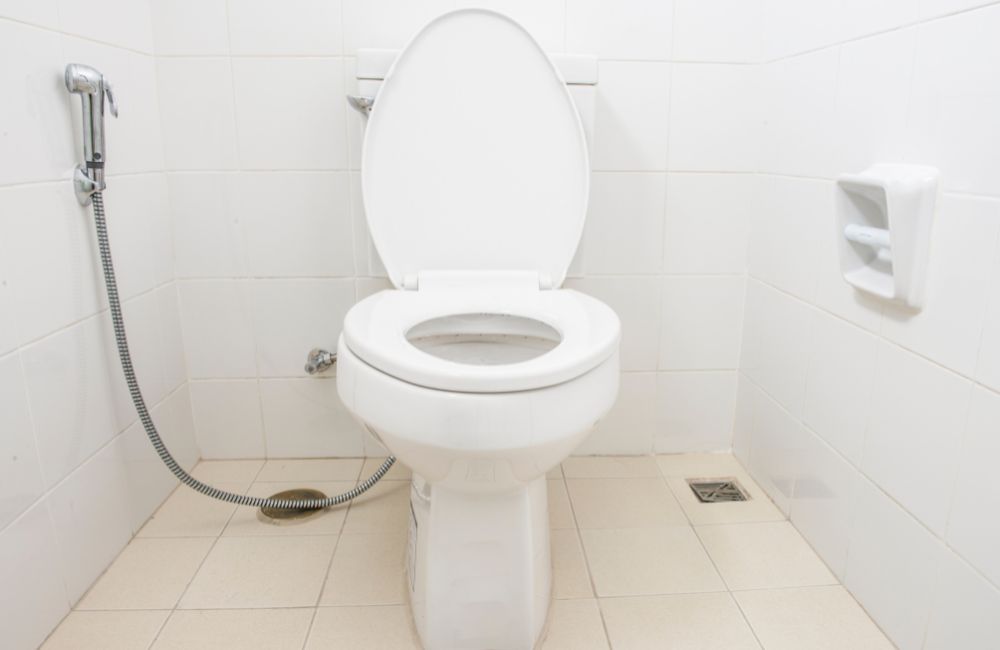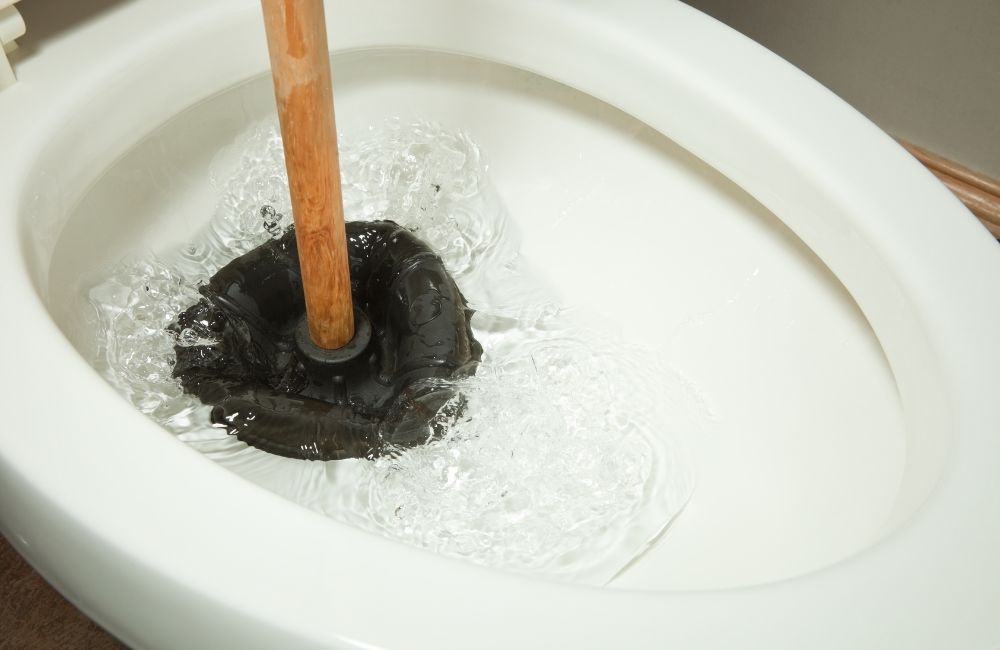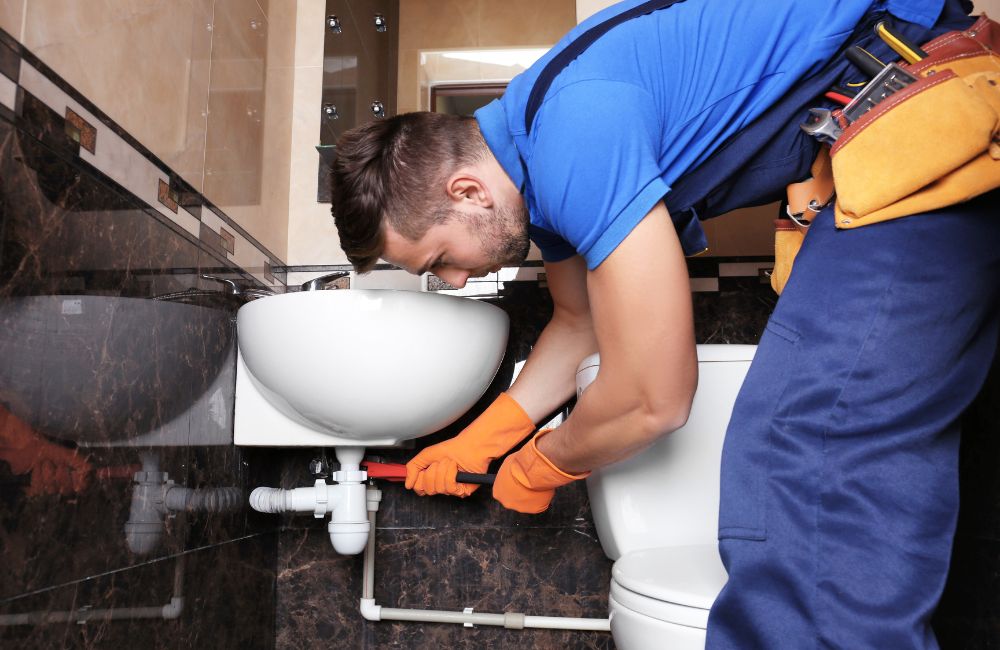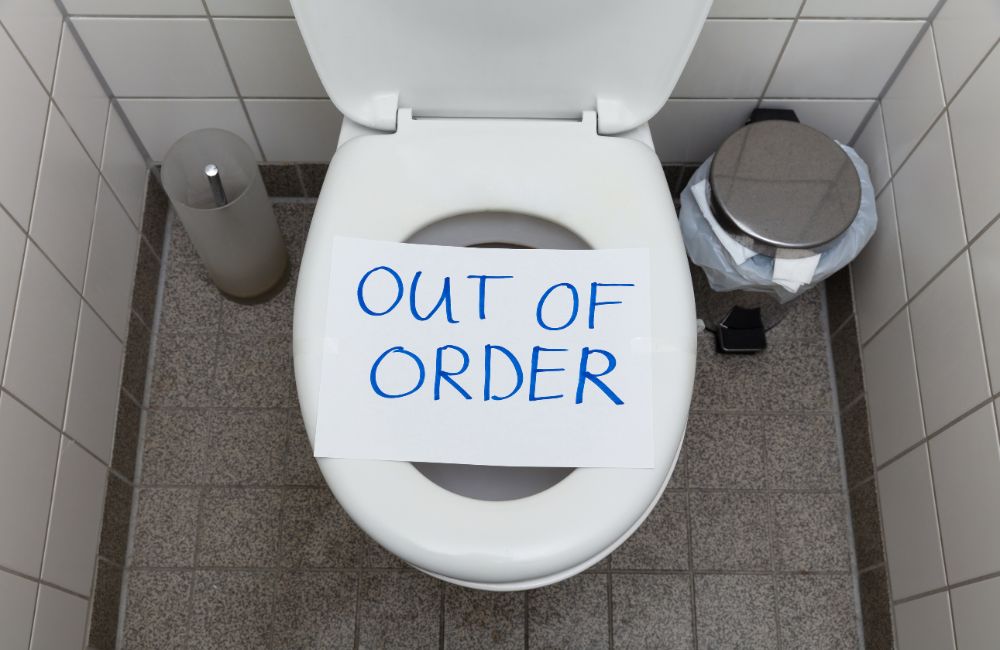Maintaining a properly functioning toilet is crucial for any household. A malfunctioning toilet can cause inconvenience and even lead to costly repairs if not addressed promptly. We will help you detect and fix common toilet problems with expert tips from a plumbing company in Torrington, CT. We will cover the most frequent issues, how to identify them, and practical solutions to keep your toilet in top shape.
Table of Contents
Key Takeaways
What Are the Common Toilet Problems?
- Running Toilet
- Clogged Toilet
- Weak Flush
- Leaking Toilet
- Toilet Not Filling Properly
How to Detect Toilet Problems
Additional Tips for Maintaining Your Toilet
When to Call a Professional Plumbing Company
Frequently Asked Questions
Get Expert Plumbing Help from L&P Plumbing!
| Key Takeaways ✔ A continuous sound of running water is often caused by flapper issues or fill valve problems. Simple adjustments or replacements can resolve this issue. ✔ Water rising and not draining properly is usually due to excessive toilet paper or foreign objects. Using a plunger or calling a professional plumbing company for persistent clogs is advised. ✔ Insufficient water flow during flushing can result from a low water level or blocked rim jets. Adjusting the water level and cleaning the rim jets can improve flush performance. ✔ Water pooling around the base or dripping from the tank is often due to faulty seals or a cracked tank. Replacing the wax ring or the damaged part can fix the leak. ✔ Slow or incomplete tank refills are typically caused by fill valve issues or water supply problems. Adjusting or replacing the fill valve and checking the water supply line can solve this issue. ✔ Regular visual inspections, listening for unusual sounds, and checking for leaks using a dye test are effective methods to detect toilet problems early. ✔ Common fixes include replacing the flapper, using a toilet auger, adjusting water levels, cleaning rim jets, and replacing faulty parts. Tools like a plunger, screwdriver, and wire brush are essential. ✔ Look for online reviews, verify credentials, get multiple estimates, and consider the company’s experience and professionalism. Ensuring transparency and good customer service is crucial. |

What Are the Common Toilet Problems?
Understanding common toilet problems and their causes is the first step to effectively diagnosing and fixing issues in your bathroom. Here are some of the common toilet problems:
| Problem | Symptoms |
| Running Toilet | The continuous sound of running water |
| Clogged Toilet | Water rising and not draining properly |
| Weak Flush | Insufficient water flow during flushing |
| Leaking Toilet | Water pooling around the base or dripping from tank |
| Toilet Not Filling Properly | Slow or incomplete tank refill |
1. Running Toilet
A running toilet is not only annoying but can also waste a significant amount of water..
Causes
- Flapper Issues: The rubber flapper can become worn out or misaligned over time, preventing it from sealing properly.
- Fill Valve Problems: If the fill valve is faulty, it might not shut off the water flow as it should.
Tools Needed
- New Flapper: A replacement for the worn or damaged flapper.
- Screwdriver: For adjusting or replacing the fill valve.
How to Fix a Running Toilet
- Inspect the Flapper: Lift the lid off the tank and check the flapper. If it’s worn or damaged, replace it.
- Check the Chain: Ensure the chain connected to the flapper isn’t too tight or too loose.
- Adjust the Fill Valve: Adjust the fill valve to ensure the water stops at the correct level.
- Replace the Fill Valve: If adjusting doesn’t help, replace the fill valve.
2. Clogged Toilet
A clogged toilet is a frequent issue that can usually be resolved with a plunger. However, persistent clogs might indicate a more serious problem. About 49% of Americans have encountered foul restroom odors caused by a clogged toilet in a business setting. This highlights the important of dealing with clogged toilets in both homes and commercial settings.
Causes
- Excessive Toilet Paper: Using too much toilet paper at once can cause a clog.
- Foreign Objects: Items such as wipes, feminine hygiene products, or toys can cause blockages.
- Plumbing System Blockages: A blockage further down the plumbing system may require a professional plumbing company to use specialized equipment to clear it.
Tools Needed
- Plunger: For plunging and clearing minor clogs.
- Toilet Auger: For breaking up or removing persistent clogs.
How to Fix a Clogged Toilet
- Use a Plunger: Place the plunger over the drain and plunge vigorously.
- Use a Toilet Auger: If plunging doesn’t work, insert the toilet auger into the drain and turn the handle to break up the clog.
- Prevent Future Clogs: Avoid flushing items that can cause blockages, such as wipes and feminine hygiene products.
3. Weak Flush
A weak flush can leave waste in the bowl and may require multiple flushes, wasting water.
Causes
- Low Water Level: The water level in the tank should be about an inch below the top of the overflow tube.
- Blocked Rim Jets: Mineral buildup can block the rim jets under the toilet bowl rim.
Tools Needed
- Screwdriver: For adjusting the fill valve.
- Wire Brush: For cleaning the rim jets.

How to Fix a Weak Flush
- Adjust the Water Level: Check the water level in the tank and adjust the fill valve if necessary.
- Clean the Rim Jets: Use a wire brush to clean the rim jets and remove any mineral buildup.
- Check the Flapper: Ensure the flapper is sealing properly to allow for a strong flush.
4. Leaking Toilet
Leaking toilets can cause water damage and increase your water bill. Household leaks, including those from toilets, can waste nearly 1 trillion gallons of water annually. Leaks can originate from several places, including the base of the toilet, the tank, or the bowl.
Causes
- Faulty Seals: The wax ring seal at the base of the toilet can degrade over time, causing leaks.
- Cracked Tank or Bowl: The tank and bowl can get cracks over time.
Tools Needed
- New Seals: For replacing faulty seals.
- Plumber’s Putty: For temporary fixes to cracks.
How to Fix a Leaking Toilet
- Identify the Leak Source: Check if the leak is coming from the base, tank, or bowl.
- Replace the Wax Ring: If the leak is at the base, turn off the water supply, drain the toilet, and replace the wax ring.
- Fix Cracks: If the tank or bowl has cracks, replace the damaged part or use a plumber’s putty as a temporary fix.
5. Toilet Not Filling Properly
If your toilet tank isn’t filling properly, it could lead to weak flushes or a toilet that won’t flush at all.
Causes
- Fill Valve Issues: The fill valve might be set too low or could be malfunctioning.
- Water Supply Problems: Check the water supply line to ensure it’s not kinked or blocked.
Tools Needed:
- New Fill Valve: For replacing a malfunctioning fill valve.
- Wrench: For adjusting or replacing the fill valve.
Addressing Fill Problems
- Check the Fill Valve: Adjust the fill valve to ensure the tank is filling properly.
- Replace the Fill Valve: If adjusting doesn’t help, replace the fill valve.
- Inspect the Water Supply Line: Ensure the water supply line isn’t kinked or blocked and that the shutoff valve is fully open.
How to Detect Toilet Problems
Knowing how to detect toilet problems early can save you time, money, and prevent minor issues from becoming major repairs. With the right techniques and guidance from a professional plumbing company, you can identify problems before they escalate.
| Detection Method | What to Look For | Tools Needed |
| Visual Inspection | Water leaks, tank water level, damage | Flashlight, inspection mirror |
| Listening for Unusual Sounds | Continuous running water, hissing, dripping | Your ears |
| Checking for Leaks | Water around the base, dye test results | Food coloring, paper towels |
Visual Inspection
- Check for Leaks: Examine the area around the base of the toilet for any water. Leaks at the base often indicate a problem with the wax ring seal.
- Inspect the Tank and Bowl: Look inside the tank for any standing water or signs of wear and tear. Check the bowl for cracks or damage.
- Water Level: Ensure the water level in the tank is about an inch below the overflow tube. If it’s too low, the flush will be weak. If it’s too high, it may cause running water issues.
Listening to Unusual Sounds
- Running Water: Continuous running water sound typically indicates a problem with the flapper or fill valve.
- Hissing Sounds: This sound often points to a malfunctioning fill valve.
- Dripping: Dripping sounds might indicate a leak somewhere in the toilet’s plumbing system.
Checking for Leaks
- Dye Test: Add a few drops of food coloring to the toilet tank. Wait 30 minutes without flushing. If the color appears in the bowl, it indicates a leak.
- Base Inspection: Check around the base of the toilet for any signs of water pooling.
- Floor Inspection: Look for damp spots on the floor around the toilet. This could indicate a leak at the base.
Additional Tips for Maintaining Your Toilet
Proper maintenance is key to ensuring your toilet operates smoothly and efficiently. With these additional tips from a plumbing company, you can keep your toilet in top condition and prevent future issues.
Regular Maintenance
Perform regular maintenance to keep your toilet in good working condition. Regular maintenance can help prevent minor issues from becoming major problems.
- Monthly Inspections: Conduct a monthly visual inspection to check for leaks or damage.
- Check Water Levels: Ensure the water level in the tank is at the correct height.
- Inspect Flapper and Fill Valve: Periodically check the flapper and fill valve for wear and tear.
Avoiding Common Mistakes
Avoid common mistakes. Instead, opt for natural solutions or call a professional plumbing company for persistent issues.
- Using Chemical Cleaners: These can corrode pipes and cause more harm than good.
- Ignoring Small Leaks: Small leaks can become bigger problems if not addressed promptly.
- Flushing Inappropriate Items: Only flush toilet paper to prevent clogs.
Water Conservation Tips
Conserving water not only helps the environment but also reduces your utility bills.
- Install Low-Flow Toilets: These toilets use less water per flush, saving water and money.
- Fix Leaks Quickly: A leaky toilet can waste a lot of water over time.
- Avoid Flushing Non-Flushable Items: This can cause clogs and waste water.
When to Call a Professional Plumbing Company
Some toilet problems are too complex for DIY solutions. If you encounter persistent issues, major leaks, or problems that you’re unsure how to fix, it’s time to call a professional plumbing company. They have the expertise and tools to diagnose and repair complex plumbing issues. Call a professional plumbing company when:
- Persistent Clogs: If plunging and augers don’t work, there might be a deeper issue.
- Major Leaks: Significant water damage or leaks that you can’t pinpoint.
- Complex Repairs: Problems with the plumbing system that require specialized tools.
Benefits of Professional Plumbing Company Help
Hiring a professional plumbing company ensures that the problem is fixed correctly and efficiently.
- Expert Diagnosis: Professional plumbing companies can accurately diagnose and fix the issue.
- Long-Term Solutions: They provide fixes that last, preventing recurring problems.
- Maintenance Advice: Professional plumbing companies can offer tips on how to maintain your plumbing system effectively.
- Access to Advanced Tools: Professional plumbers have access to specialized tools and equipment that are not typically available to homeowners.
- Guaranteed Work: Many professional plumbing companies offer warranties or guarantees on their work, providing peace of mind.
- Safety: Handling plumbing issues can involve potential hazards. Professional plumbers are trained to perform repairs safely and minimize risks.
- Time Savings: Hiring a professional can save you time and effort, as they can complete the job more quickly and efficiently than DIY methods.
- Emergency Services: Many plumbing companies offer 24/7 emergency services, ensuring you have help when you need it most.
How to Choose a Reliable Plumbing Company
When you need professional help, it’s important to choose a reliable plumbing company. Here are some tips to help you make the right choice:
- Check Reviews: Look for online reviews and testimonials from previous customers.
- Verify Credentials: Ensure the plumbing company is licensed and insured.
- Ask for Estimates: Get multiple estimates to compare pricing and services.
- Research About Experience and Expertise: Choose a plumbing company with a proven track record and experience in handling various plumbing issues.
- Ensure Availability and Response Time: Consider a plumbing company that offers 24/7 emergency services and has a quick response time. This is crucial for addressing urgent plumbing issues.
- Assess Professionalism and Communication:. The plumbing company should be courteous, willing to answer your questions, and provide clear explanations of their work.
- Verify Local Reputation: A plumbing company with a strong local reputation is likely more reliable. Ask friends, family, and neighbors for recommendations.
- Ensure Transparency in Services: Ensure the plumbing company is transparent about the services they offer and any potential additional costs. Hidden fees can be a red flag.
- Secure Excellent Customer Service: A plumbing company that values customer service will prioritize your satisfaction and be responsive to your needs.

Frequently Asked Questions
How to tell if a toilet is leaking under the tiles?
Look for loose or discolored tiles, a persistent musty smell, or water seeping from under the base of the toilet. These are common signs of a leak under the tiles. You may also notice the grout between tiles becoming darker or deteriorating. If left unchecked, the water can cause significant damage to the subfloor and surrounding areas.
How do I know if my toilet is leaking behind the wall?
Check for damp spots, mold, or discoloration on the wall behind the toilet. You might also notice a musty odor or an increase in your water bill. Listen for sounds of dripping water when the toilet is not in use. Removing a portion of the wall to inspect the plumbing can confirm a hidden leak.
How do I know if my toilet is leaking from the ceiling?
If water stains, discoloration, or damp spots appear on the ceiling directly below the bathroom, it could indicate a leak from the toilet above. Peeling paint or wallpaper and a persistent damp smell are additional indicators. Check the bathroom floor above for standing water or damage. Promptly addressing ceiling leaks can prevent structural damage.
How to tell if a toilet flange needs to be replaced?
Signs that a toilet flange needs replacement include water leaking at the base of the toilet, the toilet rocking or moving, or visible damage or corrosion on the flange. You might also notice a foul odor if the seal is compromised. A damaged flange can lead to further leaks and potential floor damage if not addressed. Inspecting the flange periodically can help catch problems early.
Can you put a new toilet flange over an old one?
It’s generally not recommended to place a new flange over an old one. The old flange should be removed and replaced to ensure a proper seal and fit. Installing a new flange over an old one can cause improper alignment and potential leaks. For a secure and effective installation, always replace the old flange completely.
Get Expert Plumbing Help from L&P Plumbing!
If you’re experiencing toilet problems and need professional help, don’t wait—contact L&P Plumbing today! Residents of Torrington, CT, can rely on our expert services to keep their plumbing systems in top shape. Our experienced team at L&P Plumbing is ready to tackle any issue, ensuring your home in Torrington, CT, stays safe and leak-free. For reliable plumbing services in Torrington, CT, reach out to L&P Plumbing and let us handle all your plumbing needs!

